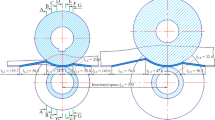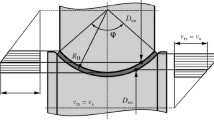The advantages and disadvantages of single-radius roll-pass design for the production of longitudinally welded pipes of small (5–114 mm) and medium (114–480 mm) diameters in an electric-resistance welding pipe mill are discussed. Double-radius (MISiS) roll-pass design and roll-pass designs for forming the workpiece periphery with constant parameters in all the stands of the forming mill are presented. For these roll-pass designs, forming “flowers” are drawn, and the trajectories for fixed fibers of the workpiece and the longitudinal-strain fields are determined for a Dt × St ∅ 50 × 1.5 mm tube. The forming patterns are compared, and the effectiveness of the forming process is assessed. It is established that all the forming patterns produce workpieces of high quality; however, to improve the process, it is advisable to apply forming patterns with a descending middle fiber in the open-pass section of TESA 30-50 electric-resistance welding pipe mill.
Similar content being viewed by others
Avoid common mistakes on your manuscript.
To produce a wide range of steel pipes with high mechanical and performance characteristics, various methods of forming a tubular billet with a tool are used [1,2,3,4,5]. The tool design and forming pattern determine the geometry of tubular billets [6,7,8,9]. Longitudinally welded tubes of various standard dimensions and steel grades are often produced in electric-resistance welding (ERW) pipe mills using single- or multi-radius forming patterns.
Single-radius roll-pass designs are widely used in ERW pipe shops due to the simple manufacturing of the tool, simple tool manufacture process design (manufacturing and reconditioning of rolls), adjustment, and operation. A single-radius tool has disadvantages, however.
Our goal here is to develop multiradius forming patterns with straight and descending trajectories of the middle fibers of the workpiece and to assess the effectiveness of different patterns. They were tested for Dt × St ∅ 50 × 1.5 mm band TESA 30-50 tubes [10]. Double-radius forming patterns are most widely used in forming mills with different parameters such as:
– dependence of curvature on the length of the deformation zone;
– length of the deformation zone and interstand distance;
– trajectory shape and length for the middle fiber of the workpiece;
– longitudinal-strain fields of the workpiece.
The curvature changes in the following forming patterns were compared:
– two single-radius forming patterns, one with straight middle fiber and the other with descending middle fiber;
– two double-radius (MISiS) forming patterns, one with straight middle fiber and the other with descending middle fiber;
– two double-radius forming patterns with constant parameters (radius and bend angle) of the periphery and the central section of the workpiece formed at large radius gradually decreasing from stand to stand; with a straight middle fiber and a descending fiber.
Figure 1 shows forming flowers for the single-radius, double-radius roll-pass designs and the double-radius (MISiS) designs with straight and descending bending zones.
The length of the trajectories of workpiece fibers for the single-radius roll-pass design (Fig. 1a) with straight bending trajectory was determined [11]. Table 1 summarizes the lengths l33, l22, l11, l00 of the trajectories of fixed fibers for the single-radius roll-pass design with descending trajectory (Fig. 1b).
Figure 2 shows the strain fields for single-radius roll-pass designs with straight and descending trajectories of fixed fibers.
The strain is maximum (0.0027) in the first open stand (OS) for the straight deformation zone. Then the longitudinal strain smoothly decreases to 0.0018 in the fourth open stand and then intensively decreases in the closed stands. If the deformation zone is descending, the strain increases to 0.0022 in the first four stands and then intensively decreases. The latter forming pattern is preferred because the total longitudinal strain decreases by 18.8%. The strain differences Δε for the open forming stands are given below:
Stand number | 1 | 2 | 3 | 4 |
Δε | 0.00122 | 0.000885 | 0.000351 | – 0.0003 |
% | 47.86 | 36.73 | 16.2 | – 18.089 |
The length of the trajectories of workpiece fibers for the double-radius roll-pass design (Fig. 1c) with straight bending trajectory was determined [12]. Table 2 summarizes the lengths l33, l22, l11, l00 of the trajectories of fixed fibers for the double-radius roll-pass design with descending trajectory (Fig. 1d).
Figure 3 shows the strain fields for double-radius roll-pass designs with straight and descending trajectories of fibers.
The longitudinal strain intensively increases to 0.0035 in the first open stand and then smoothly decreases to 0.0017 in the subsequent three stands. If the deformation zone is descending, the longitudinal strains are stable, varying within 4%, in the open stands.
The strain differences Δε for the open forming stands are given below:
Stand number | 1 | 2 | 3 | 4 |
Δε | 0.00127 | 0.001255 | 0.000364 | – 0.000006 |
% | 36.61 | 49.65 | 19.99 | – 3.77 |
Table 3 summarizes the lengths l33, l22, l11, l00 of the trajectories of fixed fibers for the double-radius (MISiS) roll-pass design with descending trajectory (Fig. 1f). The trajectories of fixed fibers are equally spaced across the width, from the center to the edge of the strip.
Figure 4 shows the strain fields for double-radius (MISiS) roll-pass design with straight and descending trajectories of fibers.
If the deformation zone is straight, the longitudinal strains peak (0.0031) in the first and second stands and then intensively decrease in the closed stands. The major deformation occurs in the first two stands. If the deformation zone is descending, the strain varies from 0.0017 to 0.0022 in the open stands and then intensively decreases. The other forming pattern produces uniform bending of the workpiece in the open stands.
The strain differences Δε for the open forming stands are given below:
Stand number | 1 | 2 | 3 | 4 |
Δε | 0.00123 | 0.000852 | 0.000257 | – 0.0002 |
% | 41.47 | 27.66 | 10.88 | – 12.34 |
Figure 5 compares the upper boundaries of longitudinal strains of the edges for the three roll-pass designs.
The longitudinal strains of the edges for all the roll-pass designs exceed the proportional limit in the range (1.2–3.0)εt. This, however, does not affect buckling and edge displacement because the experiments [13,14,15] demonstrated that the safe range of longitudinal strains of the edges during quality forming is within 0.6–0.8% of the elastoplastic range. In this connection, the roll-pass designs can be arranged in the order of effectiveness as follows: double-radius (MISiS) design with descending trajectory; double-radius design with descending trajectory; single-radius design with descending trajectory; single-radius design with straight trajectory.
Conclusions
1. The forming pattern with descending middle fiber is the most effective in quality forming with a maximum longitudinal strain of 0.0022 in 4OS, 1OS, and 2OS.
Comparing the double-radius roll-pass designs with descending trajectory with the simplest single-radius design with straight trajectory shows that the longitudinal strains of the edges decrease by 18.5%, which indicates that the descending forming patterns are preferred.
Assessing the longitudinal-strain fields of the roll-pass designs, we can arrange them in the following order of effectiveness: double-radius (MISiS) design with descending trajectory; double-radius design with descending trajectory; single-radius design with descending trajectory; single-radius design with straight trajectory.
Multiradius roll-pass designs for a forming mill can be recommended for the production of longitudinally welded pipes of small and medium diameters in continuous electric-weld pipe mills.
References
A. S. Budnikov, E. A. Kharitonov, A. S. Aleshchenko, and R. V. Iskhakov, “Effect of plugless deformation in screw rolling threeroll mill on the change of tube wall thickness,” Chernye Metally, No. 12, 41–45 (2019).
V. P. Romanenko, P. P. Stepanov, and S. M. Kriskovich, “Production of hollow railroad axles by screw piercing and radial forging,” Metallurgist, 61, No. 9–10, 873–877 (2018).
B. A. Romantsev, A. V. Goncharuk, A. S. Aleshchenko, A. B. Onuchin, and Y. V. Gamin, “Improving the regimes used for hotrolling tubes on mini tube-production unit 70-270,” Metallurgist, 59, No. 5–6, 386–389 (2015).
A. S. Aleshchenko, Y. V. Gamin, B. K. Chan, and V. Y. Tsyutsyura, “Wear features of working tools during piercing of hightemperature alloys,” Chernye Metally, No. 8, 63–70 (2018).
E. A. Kharitonov, V. P. Romanenko, and A. S. Budnikov, “Pipe behavior in a three-roller screw-rolling mill,” Steel in Transl., 44, No. 10, 769–772 (2014).
A. P. Kolikov and D. Y. Zvonarev, “Expansion of large-diameter welded pipe,” Steel in Transl., 47, No. 3, 210–212 (2017).
M. V. Kadach, A. N. Koshmin, Y. V. Gamin, and B. A. Romantsev, “Obtaining steel tubular items of variable cross-section along their length,” Chernye Metally, No. 4, 37–41 (2019).
V. Y. Osadchii, E. A. Gaas, D. Y. Zvonarev, and A. P. Kolikov, “Shaping of thick sheet in the production of welded large-diameter pipe,” Steel in Transl., 44, No. 5, 374–378 (2014).
A. P. Kolikov, D. Yu. Zvonarev, I. M. Taupek, and T. Yu. Sidorova, “Mathematical simulation of strip plastic deformation process in the whole technological stage of manufacture of large-diameter tubes,” Chernye Metally, 1, No. 7, 41–45 (2017).
S. V. Samusev, A. S. Aleshchenko, and V. A. Fadeev, “Simulation of the process of continuous forming of straight-seam welded pipes on the basis of Tesa 10-50 Trainer,” Izv. Chern. Metallurg., 61, No. 5, 378–384 (2018).
S. V. Samusev and V. A. Fadeev, “Studying the continuous forming of a tubular billet in TESA forming mills of different configurations,” Proizv. Prokata, No. 5, 3–8 (2019).
S. V. Samusev and V. A. Fadeev, “Analyzing the parameters of the bending zones of a strip in TESA 30-50 forming mill,” Kuzn.- Shtamp. Proizv. Obrab. Mater. Davlen., No. 3, 14–18 (2019).
B. Abeyrathna, B. Rolfe, P. Hodgson, and M. Weiss, “Local deformation in roll forming,” Int. J. Adv. Manufact. Technol., 88, No. 9–12, 2405–2415 (2017).
V. A. Rymov, P. I. Polukhin, and I. N. Potapov, Improving the Production of Welded Pipes [in Russian], Metallurgiya, Moscow (1983).
Yu. M. Matveev and Ya. L. Vatkin, Roll-Pass Design for Pipe Mills [in Russian], Metallurgiya, Moscow (1970).
Author information
Authors and Affiliations
Corresponding author
Additional information
Translated from Metallurg, Vol. 64, No. 7, pp. 55–59, July, 2020.
Rights and permissions
About this article
Cite this article
Samusev, S.V., Fadeev, V.A. & Sidorova, T.Y. Development of Effective Roll-Pass Designs for Production of Longitudinally Welded Pipes of Small and Medium Diameters. Metallurgist 64, 658–664 (2020). https://doi.org/10.1007/s11015-020-01042-4
Received:
Published:
Issue Date:
DOI: https://doi.org/10.1007/s11015-020-01042-4









